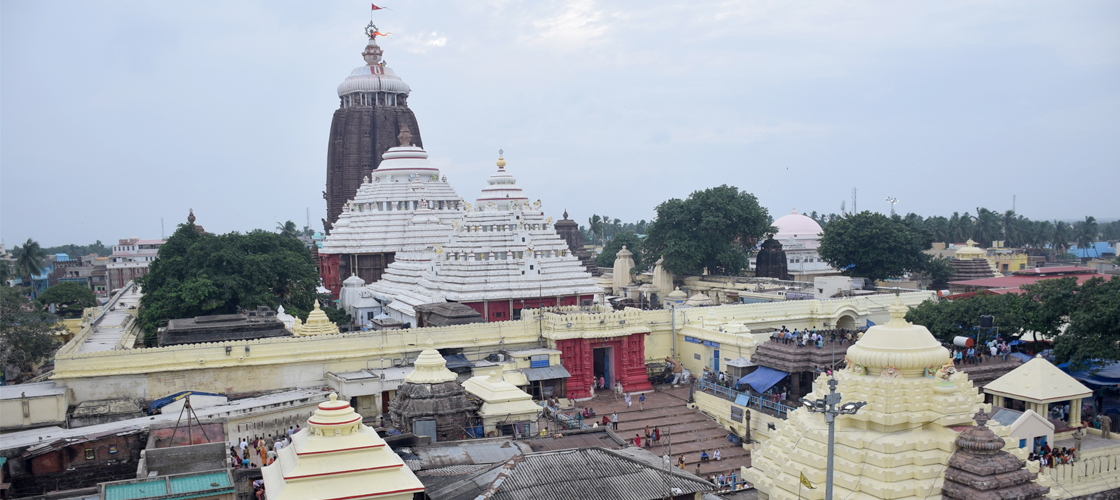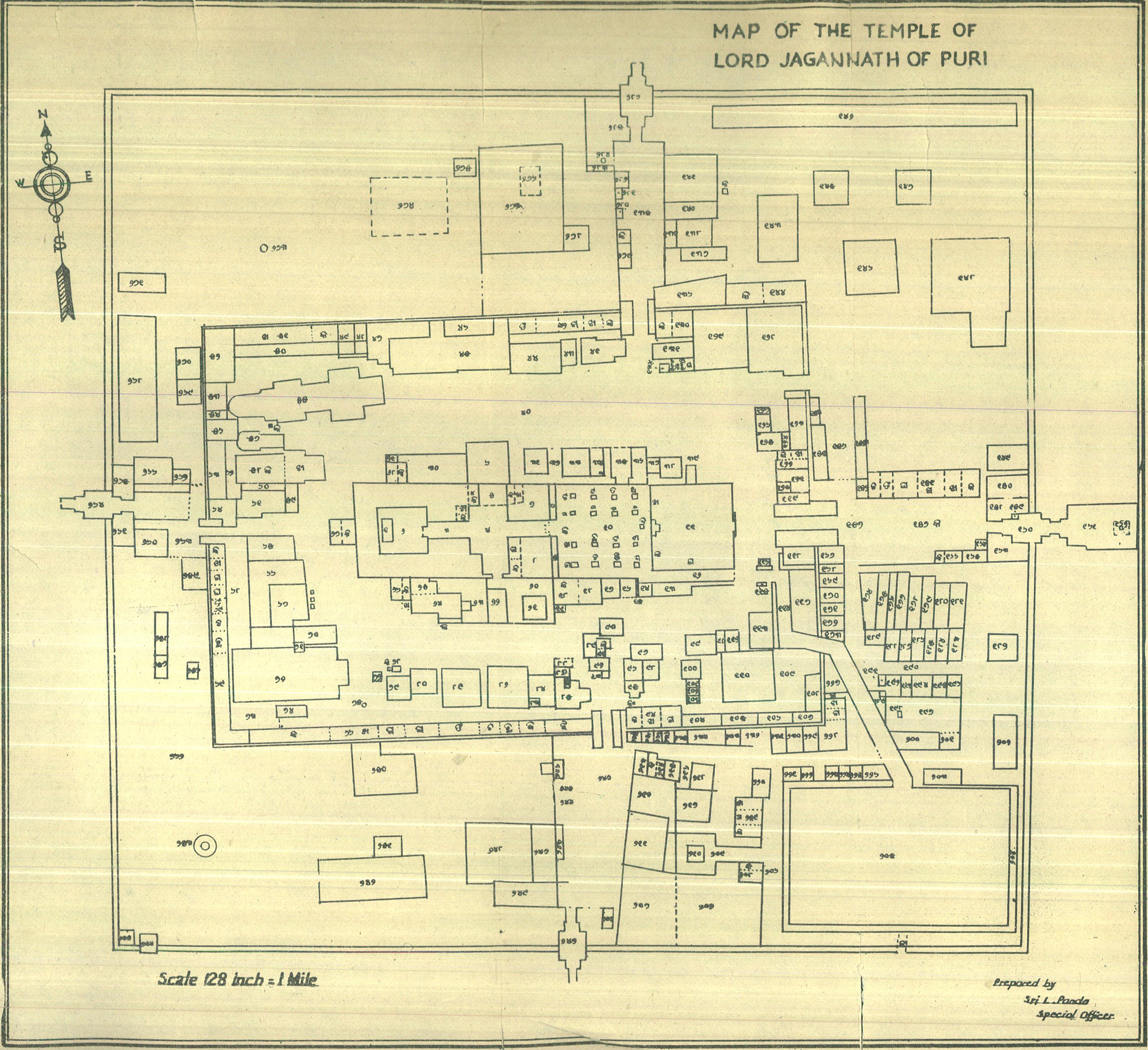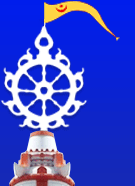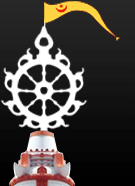Shreemandira >> Bhitara Bedha (Inner Compound)
Besides main temple, there are other temples in the inner compound. According to a map of the temple in the Record of Rights the temples, bije sthalis and there deities are listed below.
| Temple / Bijesthali | Gods / Goddesses |
| 1. Garbhagruha | Shree Balabhadra, Shree Jagannatha, Devi Subhadra, Shree Sudarshana, Bhudevi, Shreedevi and Madhava. |
| 2. Bhandara Ghara | Lokanath (Bije Pratima), Pahuda Sayana Thakura and Durga. |
| 3. Thakura Sayana Ghara | Sayana Thakura, Thakurani (3 images). |
| 4. Jagamohana | Garuda Stambha, Charcha Ganesha, Khamba Gayatri, Khamba Nrusimha, Khamba Dakshina Kali, Khamba Sheetala, Chakra Narayana, Khamba Vimala, Sugreeba, Bibhisana, Mangala, Chaitanya, ShreeKrushna, Mahaveera, Panchamukhi Mahaveera (Hanuman). |
| 5. Bhogamandapa | Ganesha, Bramha, Mahadeva, Kalika, Nrusimha. |
| 6. Bata Balabhdra | Balabhadra or Balarama. |
| 7. Indrani Deula | Indrani Thakurani. |
| 8. Patitapabana (Purana Panda Ghara) | Patitapabana (Jagannatha). |
| 9. Majana Mandapa (Marriage Platform) | |
| 10. Dakshina Ghara (Bije Pratima Ghara) | The moving images of Rama, Lakshmana, Seeta and Hanumana, Fixed images of Rama, Krushna, Narayana, the moving images of Narayana, Ram, Krushna, Madanamohana, Dolagovinda, the fixed images of Badrinarayana, Ladugopala, Bamana, Lakshminarayana and Sheshadeva, Pancha Pandava, Shalagrama (18 numbers) the images of Mahalakshmi and Veerabhadra on the wall. The pictures of Dasabhuja Durga, Ganesha, Kartikeya, Hanumana, Iswara-Parbati, Bheemeswari, Harachandi, Bedha Durga, Danteswari and Hanumana on the outside. |
| 11. Varaha Temple | Varaha Deva |
| 12. Ekadashi Temple | Devi Ekadashi |
| 13. Nisha Nrusimha Temple | Nrusimha |
| 14. Bali Bamana Temple | Bamana, Ganesha |
| 15. Navi Kata Mandapa | Hanumana |
| 16. Garada Ghara | Narayana and Hanumana |
| 17. Radha Krushna Temple | Radha and Krushna |
| 18. Pataleswara Temple | Shiva Linga (situated near the north gate of Kurma bedha. The door of this temple is towards the east. Ancient rock edicts are there in the temple). |
| 19. Hayagreeba | Hayagreeba Deva. |
| 20. Sara Ghara (plot no-42) | Tandaba Iswara, Ganesha (painted image), Kalindiswara. |
| 21. Shree Rama Chandra Temple | Rama Chandra. |
| 22. Dadhi Bamana | Dadhi Bamana (Jagannatha). |
| 23. (Konarka) Suryanarayana Temple | Sun (Moving images also there). |
| 24. Barddhamana Temple | Radhaballava and Lakshminarayana. |
| 25. Nabagraha Temple | Nabagraha (nine planets),Samaleswari, Rama, Seeta, Lakshmana and Hanumana. |
| 26. Lakshmi Temple Roshaghara (kitchen) | |
| 27. Lakshmi Narayana Temple | Lakshmi and Narayana. |
| 28. Shree Lakshmi Temple | On the throne is seated goddess Lakshmi, on the walls of its Jagamohana, there are the pictures of Ganesha, Hanumana, Nrusimha, Varaha and Lakshmi Nursimha. |
| 29. Bedha Kali Temple | Kali Thakurani |
| 30. Neelamadhava Temple | Neelamadhava |
| 31. Bhubaneswari Temple | Maa Bhubaneswari is there in the inmost room, in the outside room there are Saraswati, Sasthi, Savitri and Gayatri. |
| 32. Khirachora Gopinatha Temple | Radha and Krushna |
| 33. Kanchi Ganesha (Bhanda Ganesha) | Ganesha/ Ucchista Ganapati or Tantrik Ganesha |
| 34. Sakshi Gopala Temple | Radha and Krushna |
| 35. Mandani Ghara | Gopeswara Mahadeva, Nanda, Yashoda, Vasudeva, Devaki, Dama, Sudama, Balarama, Gopala, Nrusimha, Ramachandra, Hanumana and Anasara Tati deities. |
| 36. Benumadhava Temple | Krushna |
| 37. Vimala Temple | Goddess Vimala (on the wall, Dasamahavidya, Ganesha, Kartikeya, Chhaya, Maya) |
| 38. Badri Narayana | Narayana |
| 39. Golaka Bihari Thakura (Sara ghara) | Krushna |
| 40. Rohini kunda | Chaturbhuja Kaka and Vishnu Padapadma |
| 41. Natua Ganesha (Kanchi khuri Ganesha) | A south facing temple in front of Vimala temple. A beautiful image of eight armed Ganesha made of Granite, dancing on his ’Vahana’ (carrier) rat. |
| 42. Shree Nrusimha Temple | Nursimha |
| 43. Mukti Mandapa (Brahmasana) | Ganesha and Kali |
| 44. Mukteswara | Shiva |
| 45. Ananta Vasudeva Temple | Krushna |
| 46. Kshetrapala | Mahadeva |
| 47. Kuttama Chandi | Chandi |
| 48. Surya Yantra Temple | The yantra of Surya (the Sun God is worshipped here everyday) |
| 49. Pancha Pandava Temple (Plot No.-90) | Markandeswara, Yameswara, Lokeswara. |
| 50. Bata Krushna (Plot No.-92) | Krushna |
| 51. Pancha Pandava Temple (Plot No-91A & 93) | Pancha Shiva Linga at both the places |
| 52. Varaha Narayana (Plot No.-91) | Varaha Avatara |
| 53. Radha Krushna (Plot No.-94A) | Radha and Krushna |
| 54. Bata Patitapabana (Bata Abakasha) | Jagannatha |
| 55. Bala Mukunda | Bala Krushna |
| 56. Bata Krushna (Plot No.-99) | Krushna |
| 57. Bata Mangala Temple | Mangala |
| 58. Pada Padma | Lotus feet of Krushna |
| 59. Hari Sahadeva Temple | Shiva Linga |
| 60. Merda Rosha Ghara (Old Kitchen) | (on the wall, picture of Ganesha, Mahaveera, Saraswati) |
| 61. Bata Krushna Temple (Plot No- 111) | Krushna |
| 62. Radha Krushna (Radharamana) | Radha and Krushna |
| 63. Satyanarayana Temple (Plot No-113) | Narayana |
| 64. Agneeswara Temple | Shiva linga |
| 65.Brundabanachandra Temple (Sara ghara) | Krushna |
| 66. Bata Ganesha Temple | Ganesha |
| 67. Seeta Raghunatha (Sara ghara) | Seeta and Raghunatha |
| 68. Tretayadeva Temple | Shree Jagannatha, Shree Balabhadra and Devi Subhadra |
| 69. Chakagopala Thakura (Sara ghara) | Krushna |
| 70. Shree Chaitanya Temple | Shree Chaitanya |
| 71. Sua-Sari Deula | Ramachandra |
| 72. Shyama Rai | Shyama Rai and Ananda Vasudeva |
| 73. Bimana Sara ghara (Temple Branch Office) | Mahaveera |
| 74. Satya Narayana (Plot No.-130) | Satya Narayana |
| 75. Pada Padma and Chautara | Chaitanya lotus feet |
| 76. Garbaganjana Mahaveera (the inner compound or the gumuta) | Mahaveera (Hanumana) |

Some Important Temples (inner compound)
Vimala Temple– It is the oldest temple located in the inner compound of the main temple facing the east. There is the mention of Maa Vimala in the Matsya Purana, Kapila Samhita, Skanda Purana, Tantra Chudamani, Devi Bhagabata etc. It is said in the Tantra Sastra (Tantric Scriptures) that Maa Vimala and Shree Jagannatha are Bhairavi and Bhairava. The image of the goddess is said to have been built in Laksa (wax). She is four-armed. In three hands she holds an aksamala (rosary), a human figure and a kalasa (jar), while her fourth hand is in ‘Varada’ pose. This is a famous ‘Shakti Pitha’ of India. The Prasada of Shree Jagannatha is offered to Vimala. Saradiya Shola puja and special ritesare observed during the month of Aswaina in this temple every year.
Satya Narayana Temple– This temple enshrines the four-armed image of Shree Narayana, The upper right hand holds a disc, the lower right hand presents the ‘Abhaya mudra’, the upper left hand holds a conch and the lower wields a mace. The image is made of granite, it is 5 feet high. On both sides stand Jaya and Vijaya, at the feet of the Satya Narayana is placed Garuda kneeling down. The temple faces north.
Agneeswara Temple– This temple lies on the north-east corner of the passage that goes from the Bhoga Mandapa to the kitchen. He is regarded as the guardian of the fire of the kitchen.
Shree Nrusimha Temple– There is a temple for Nrusimha towards the southern side of the temple within its inner enclosure and this temple also faces to the east. The temple is a Panchratha Rekha Deula without a Jagamohana. It was built before the present Shree Mandira was constructed. Ancient stone inscriptions are there on the outside wall.The presiding deity of the temple is Nrusimha and a very small image of the deity is placed inside the temple on a high seat.
Lakshmi Temple– The temple of Lakshmi is situated on the north-western corner of the inner enclosure of the temple. It is believed that the temple was constructed by some ruler of the Ganga dynasty in the 12th-13th century A.D. The temple is almost contemporary on architectural style to the temple of Jagannatha, Goddess Lakshmi is worshipped in the sanctum of the temple. She is a form of Gajalakshmi, holding two elephants in the upper two hands. She is four armed and the lower hands show ‘abhaya’ and ‘varada’ postures.
Surya Temple– This temple is situated on the northern side of the temple of Shree Jagannatha and faces the east. It is saptaratha in plan. The presiding deity of the temple is Surya, the Sun God. The image of the Sun installed in the temple is stated to have been brought from Konark by King Narasimha Deva of Bhoj dynasty (1622-1647 A.D).
Bhubaneswari Temple– Bhubaneswari stands in the western side of the temple, facing the east. In its Jagamohana, an image of Saraswati is housed towards the southern side, while the images of Savitri, Gayatri and Sasthi are installed on the northern side.
Nrutta Ganapati– The temple of this deity is situated in the south-western corner of the temple, facing the south. Inside the temple is installed a dancing image of Ganapati with eight arms. The temple is believed to have been erected sometime in the 13th century A.D.
Bata Ganesha– It is a notable temple dedicated to Ganesha below the Kalpabata within the temple premises. This is known as Bata Ganesha temple The figure of His vehicle, the mouse is installed in front of the temple. References are available to the effect that poet Jagannatha Das of the 16th century used to sit beside this temple and recite his compositions of Odia Bhagavata to a large congregations.
Kanchi Ganesha-The deity is also known as Bhanda Ganesha. This temple stands on the western side of the temple premises. The image is stated to have been brought from Kanchi by Gajapati Purushottama Deva during his Kanchi expedition. The deity is four armed with the image of his consort placed on his lap. From the erotic nature of the deity, the image is believed to be a Tantric image.
Kalpabata (Tree)– There is a big banyan tree within the inner enclosure of the temple on its southern side. The tree, known by the name ‘Kalpabata’, finds mention in Skanda Purana and Brahma Purana. Persons circumambulating the tree and stepping on its shadow attain ‘Kesavalaya’ i.e, the abode of Vishnu.
Rohini Kunda (Pool)– It is stated in Skanda Purana that in the navel area of this kshetra, there are three things, i.e, the Rohini Kunda, the Kalpabata and the image of God. The said Kunda (Pool) is situated slightly on the western side of the banyan tree. It is considered sacred due to the presence of Vishnu and Lakshmi. Now this Pool is Visible in the form of a water-vat made of stone, which does not contain natural water. Inside the Vat, there are two carvings, in two separate squares, one of the Nila Chakra of Vishnu and the other of a four-handed crow. Water is poured there and it is sprinkled on the pilgrims.
Mukti Mandapa (Brahmasana)– The Mukti Mandapa is 38’ in length and 38’ wide. It is square in size. It has 16 pillars. According to Madalapanji, it was renovated by Gourirani, the wife of Mansingh, the chief of the army of the Mughal Emperor Akbar. Brahmin pandits belonging to certain villages and Dandi sanyasis, Jagadguru Sankaracharya, Deula Purohita and Rajguru’s are entitled to sit on the Muktimandapa.






